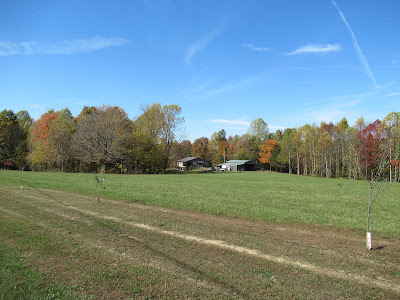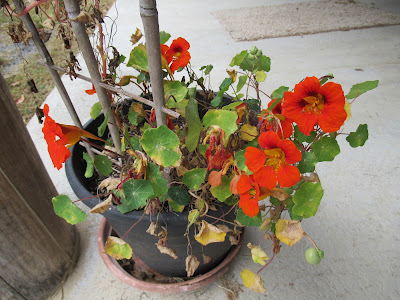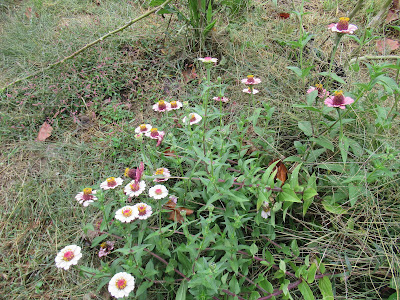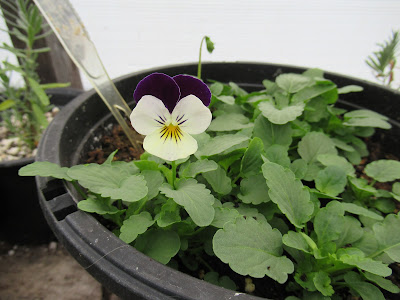Several days of drizzling rain, light winds, leaves drifting down.
Strangely, a spell of rainy weather seems to last longer than the documented actuality. Looking over the notes I scribble in each day's calendar space, I note that we've had a mix of October weather; quite a few days have featured a sequence of sun and clouds.
The black walnut trees at the bend in the lane are among the first to lose their leaves.
The ground along the south ravine is a collage of colors and shapes.
I noted yesterday that the earliest fallen leaves have softened into a rain-slicked mat their colors somber and blackened.
Wearing boots and a thick hoodie I worked in the gloom of Monday afternoon, hauling potted nasturtiums into the greenhouse, geraniums into the sun room. The nasturtiums will not long survive in the unheated greenhouse, but the pots can be shoved under the benches in the hope of seedlings emerging in spring from the seeds I've left to ripen and drop into the soil.
[Note to Willis-the Cat who considers the greenhouse his winter quarters: pots filled with soil are not intended as cat latrines!]
I tell myself each autumn that I must be sensible about what plants are brought in to over-winter. I have several summer's worth of straggling geraniums, shabby begonias, rosemarys started from cuttings. The table in the sunroom is crowded, smaller plants are ranged under the light strip in the middle ground floor room, yet I am reluctant to cull. Surely anything which has survived the frost has a right to continued living quarters?
There are still the four largest potted rosemarys lined against the screened porch wall.
The heavy pot containing my 5 year old lemon verbena has been dragged from the back porch to the downstairs living area. As soon as the leaves begin to drop I will prune back the branches.
A last photo of the gallant yellow 'mini-zinni' growing in the gravel near the porch steps.
As morning sun warmed the area the petals withered to a frosted brown.
The nursery bought 'Profusion' zinnias had one last blooming after surrounding companions had given up. They too are now bleached and limp.
The hibiscus in the south-facing raised bed built against the greenhouse wall has also succumbed to frost.
Double Knock-out roses gathered just before dark.
Samaritan Jo in a beautiful second blooming. Hours after taking this photo the blossoms were ravaged by the largest slug I've ever encountered.
Willis trudges behind me on my meandering tasks about the dooryard.
His many mis-adventures over the years have left him with an arthritic gait, but he takes his job as yard foreman seriously still.
The light frost has cleared the skies. A few golden leaves cling to the very tops of maples and tulip poplars. The purple leaves of the ash trees are gone. Hickories hold their glow of bronze and russet, oaks are still towers of green.
Pegging sheets on the back porch lines mid-morning I noticed how the nearly leafless trees to the south allow the sun in its flattening arc to spill onto the porch and through the south windows of the house. Walking up the lane to the mailbox I wished I had put a down vest over my hoodie. The frost, light though it was, has changed the quality of the air, heightened the scent of chilled grass and decaying leaves. Woodsmoke, the quintessential breath of autumn, hangs in the clear sharp air.
At lunchtime a bluebird blundered through the gap in the porch screen where through the summer the hummingbird feeders dangled. The bluebird perched on the back of a porch rocker for a moment as though considering his dilemma, then whisked through the slit screen and was on his way.
The bluebirds have been absent since their maddening and messy antics of early summer.
It has been several days since I've seen the procession of 10 wild turkeys who have been regular visitors.
Devin viewing the turkeys several weeks ago with his hunting binoculars, noted that the hen turkey has the look of an older bird and that 4 of the 9 offspring are identifiable as young toms.
Jim, looking out the window as he dressed this morning, noted several deer browsing at the lower end of the west meadow.
Herman, the feral cat, arrives before dark to snatch his share of kibble.
We've not seen a raccoon in weeks but the unwelcome possums continue to rootle in the cat's dish for any tidbits.
Now at nearly dusk I can swivel in my desk chair to glance out windows to south, north or west. Standing for a moment at my west bedroom window I take note of the rusty orange smudge left by the setting sun, the etching of nearly bare branches against the softening hues of dusky blue and grey. The clouds of peach and lavender which pillowed the eastern sky only a few minutes ago are fading. The wind is rising and more leaves slip loose from their moorings to ride the downdraft. Above the neighbor's field a hawk-- or maybe a lone turkey vulture-- circles beneath the shifting layers of grey, finally disappearing, taking his reconnaissance to another quarter of the pasture.
So much misery, so much suffering and loss in the world, so much uncertainty.
Still tomorrow we turn a calendar page and the season moves on as inexorably as it has always done.
































